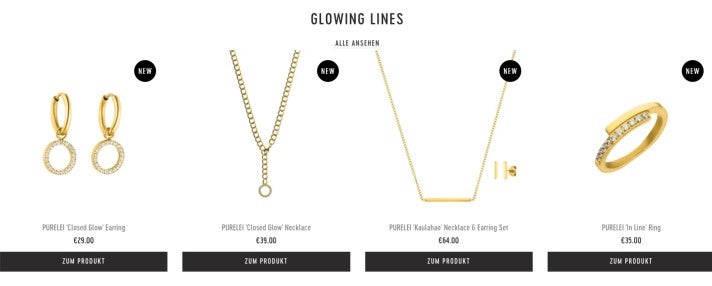
Brands like Kapten & Son showed early on how brands could overcome challenges by leveraging influencer partnerships and clever Instagram strategies. The founders behind Mannheim, Germany-based startup Purelei drew inspiration from this playbook. Today, we’re taking a closer look at the team behind the company’s impressive rise to an annual revenue of 8 figures in less than three years through targeted use of influencers, weekly collection specials and partnerships with Westwing, Disney and Glossybox.
“I was already in Hawaii in 2012 and then decided to do a semester abroad there while at university. I just fell in love with the land and the life there,” Alisa Jahnke told OMR. She studied business administration and wanted to pursue a career in a creative” sector. So Jahnke began designing a line of jewelry—inspired by Hawaii. She christened the company Purelei combining pure with the Hawaiian word for necklace, lei. In December 2016, the company launched with a shop on Shopify, selling armbands initially, and an Instagram account. “My co-founders Etienne Espenner and Frederik Jahnke also ran a cell phone accessories shop in year one of Purelei on the side; they joined full-time in early in 2018 after recognizing the potential in Purelei,” says Alisa Jahnke. Ever since, business has been booming and done so with influencers, collabs and drops.

A sample of Purelei articles
Be where the target group is
Today, the company employs 100 and makes 8 figures in annual revenue from sales of its armbands, chains, rings and watches and no longer distributes solely in Germany. “Initially, we released products in a lower price segment, such as armbands. It was great to get off the ground, to give customers a chance to get to know us,” she says. “We quickly saw, however, that the brand and its story resonated thanks to the Hawaiian touch. That permitted us to expand the product range to chains, earrings and now watches.” Purelei primarily sells through its own shop and a bit through Amazon, but handles order processing at its warehouse in Mannheim itself. Who are the primary buyers? “Our target group between the early-20s and mid-30s, spends a considerable amount of time on social media, makes regular purchases online and is interested in fashion and trends,” says Jahnke.
The best way to reach this target group in 2016 was and is today through influencer marketing—something that’s not lost on the young Purelei team: “Early on we began writing influencers and sending them jewelry; many actually presented our jewelry too. At the time, I thought that was peak influencer marketing. But it turned out to be just the beginning,” she said. The goal is multifaceted. “Initially, revenue generated from partnerships with influencers was the most important factor. And that’s because we grew straight from our cash flow and our goal was to at the very least recoup the budget invested,” says Jahnke. To track an influencer campaign’s success, Purelei used rebate codes. “The most important thing with influencer marketing and follower growth is social proof. Having more followers simply increases the faith potential customers will have in you.”
Reach begets trust
The strategy would seem to have paid off. Through mentions of the jewelry on a slew of smaller and larger influencer accounts in Germany, the Purelei Instagram account steadily grew and has now approx. 420k followers. According to analysis tool InfluencerDB the company is reaching its intended target audience: 96 percent of all followers are female, the majority of which are between 18 and 34. “From the start, we did a lot of testing to see which people best fit the brand. That’s a process that you first have to learn and we’re no exception. The primary goal at first is amassing reach,” says Jahnke. “Many girls were on board immediately and our business relationships have developed into more of a business friendship. This helps us with our planning which in turn increases the trust among our followers.”
One of these aforementioned long-term partnerships is with Influencer Jaqueline Vazzola who goes by the name of “Fashionpuglady” on Instagram. She publishes a new picture of herself almost daily, always in a new outfit and her 220k followers can see her wearing Purelei items in many of the images. Occasionally, she mentions the brand by name in the description, oftentimes, however, she just links the picture to the Purelei account. Influencers like Vazzola are a perfect fit for a brand like Purelei. They are paragons of fashion for so many young women, the majority of whom can afford a Purelei item. Gold plated chains on Purelei run for around EUR 40, earrings EUR 30 and watches for between EUR 90 and 150.
Partner with brands big and small
“The role of influencers today is no longer primarily that of a sales channel; they need to be a brand ambassador,” says founder Jahnke. To this end, the company enters partnerships with influencers that go well beyond the confines of the world’s most popular image platform. “Last year, we released four different collections with influencers. It shakes things up a bit and the collections so far have been super.” Purelei collections with influencers include singer Sarah Lombardi (1.4 million Instagram subscribers)) and influencers Kimberly Devlin-Mania (460,000 subscribers) and Liz Kaeber (840,000 subscribers), all of whom hand a hand in designing the collection.
Beyond prioritizing influencer deals, Purelei focuses on collaborations. In conjunction with the release of Disney’ reboot of Aladdin last year, Purelei released a collection inspired by 1001 Arabian nights. Another Disney collection is on the market already, too, with Mulan inspired jewelry. Whenever the film is released in theaters the collection will be featured again. “Working together with a company like Disney reinforces the trust we have built up among our customers,” says Jahnke. Purelei has also worked with German interior designer Westwing and with beauty box subscription provider Glossybox. At the Berlin Fashion Week in early 2020, Purelei also designed the jewelry for Austrian fashion designer Marina Hoermanseder its first foray into the fashion world.
Create hype for new collections
“What really helped us on Instagram were giveaways on other brand’s channels, regular live videos and that we presented ourselves as founders from the beginning. That gave the community a chance to get to know us immediately,” says Jahnke. The Instagram channel is now big enough to generate enough hype for new products on its own. “Every week, we try something new on our channel. Sometimes that’s a themed week, the most recent of which was a DIY week, where one DIY video on jewelry maintenance really did well on IGTV,” says Jahnke. “The main thing is to release new content daily. Instagram Stories are our megaphone and we frequently ask our community what designs they would like to see or which design of two provided they like the most.”
Whenever a new collection is primed for launch, Purelei generates maximum awareness for the new items via its Instagram account. “Last year, we began teasing new products on Instagram. For example, we use pre-sales measures to prime the hype,” says Jahnke. Such measures center around letting fast movers purchase an item before the official release. With new products released regularly, there is ample opportunity to prime the hype: “We launch 3 to 4 new products per month and we try to always do something new at the beginning,” says the young founder. New collections, like the upcoming Mother’s Day collection or International Women’s Day are released to coincide with an event. Before corona hit, the team used pop-up stores frequently for new product lines. Purelei then focuses on transforming the attention new lines generate via Instagram Shopping into online shop visits; each Instagram post contains a direct link to the product’s shop page.
Less focus on other platforms
Purelei also has a presence on Facebook, Pinterest, Youtube and Tiktok—but each has a varying degree of priority. Despite its roughly 100K followers on Facebook, the channel seems deserted. The posts there are solely designed to redirect customers into the shop and primarily consist of a product image and quote customer reviews. It gives the Facebook page more of a store window feel than that of an actual social media channel. Analysis tool Similarweb puts the amount of traffic that its Facebook channel generates for the shop at around 15%, while Instagram is responsible for 25% of traffic. After a closer look at the ad history, it becomes apparent, too, that Purelei has paid for a relevant portion of this traffic. Purelei is currently running 102 ads on Facebook and Instagram in Germany alone. Jahnke says that they are the most relevant channels for performance marketing purposes.
Long term, Jahnke says that Purelei intends to focus more on Youtube. Currently, only 646 people have subscribed to the channel; Purelei did, however, only begin using the channel four months ago. “Youtube as a channel is less fickle, which makes it more predictable,” says Jahnke. Speaking of fickle platforms, Purelei has already uploaded numerous videos to TikTok, which have generated 8000 followers and 74,000 likes. A recent clip with German singer Vanessa Mai generated 10,000 clicks on TT. We’re currently testing which content works best on TikTok. We’ve got a lot of creative people working for us who make a lot of TikTok videos in their spare time,” says Jahnke. She added that there is a dedicated TikTok channel on the company Slack where people post their videos, some of which then end up on the company’s official TikTok page—it’s the perfect pastime for remote working.























